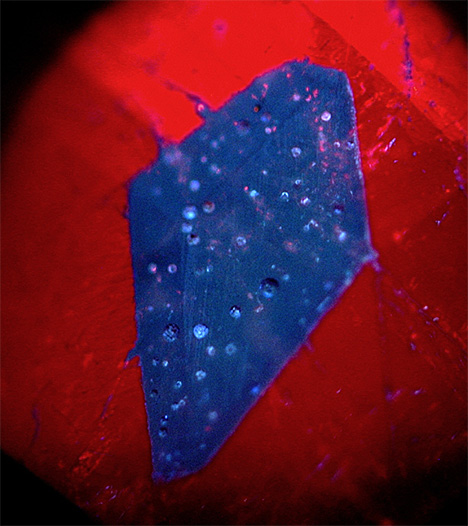Unusual Repair of a Natural Emerald

A 5.24 ct bluish green emerald (figure 1) was presented to the State Gemmological Centre of Ukraine for identification and determination of the presence of treatment. The client reported that this stone was mined in Colombia. The stone exhibited a refractive index of 1.566–1.571, birefringence of 0.005, hydrostatic specific gravity of 2.67, moderate pleochroism with bluish green to green colors, and a very weak pink fluorescence to long-wave and short-wave UV. Qualitative analysis using EDXRF spectroscopy showed major amounts of vanadium, chromium, and iron and minor amounts of gallium.
Magnification with a gemological microscope revealed an abundance of fluid growth tubes, as well as two-phase and three-phase inclusions. Thick masses of gray matter were revealed inside the cracks of the emerald. Infrared spectroscopy (FTIR) was subsequently performed to analyze this gray substance. Epoxy resin peaks at 3060, 3035, 3000, 2964, 2932, and 2871 cm–1 confirmed an epoxy resin treatment (M.L. Johnson et al., “On the identification of various emerald filling substances,” Summer 1999 G&G, pp. 82–107).


DiamondView imaging clearly revealed the epoxy resin filler within the fissures as a series of blue lines extending over the entire surface against the emerald’s red-fluorescing bodycolor (apparently due to the presence of the Cr3+ impurity). Additionally, careful examination from all sides of the stone revealed a patch in one of the corners. This patch was covered with rounded pits and glowed strong blue in the DiamondView (figure 2). In daylight, there was a clear, even border between the patch and the emerald (figure 3). EDXRF analysis showed additional admixtures of potassium and calcium on the side of the patch. All of these properties suggest that glass was the raw material for this patch, which was presumably used to conceal a damaged part of the cut emerald. This kind of repair is extremely unusual for cut stones.



